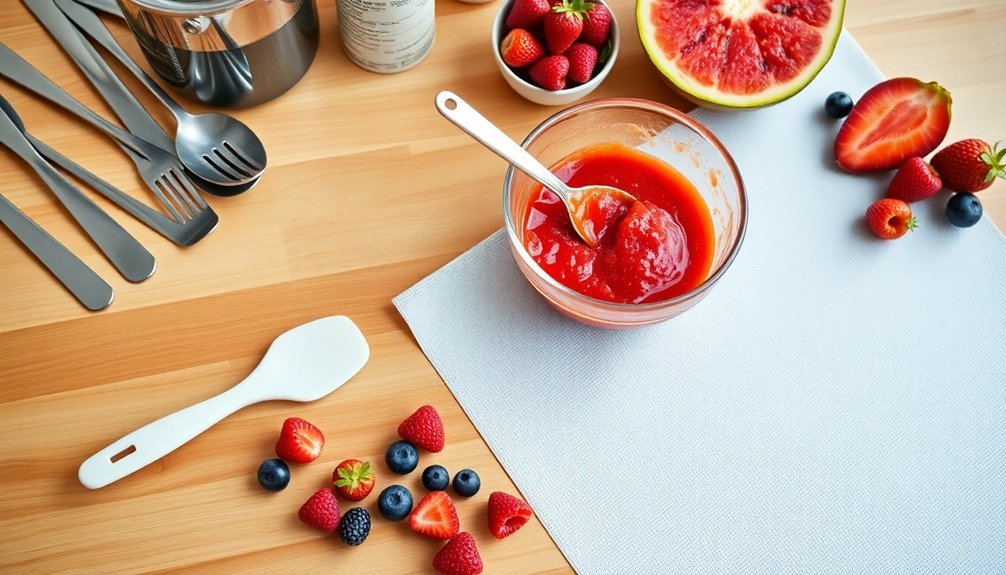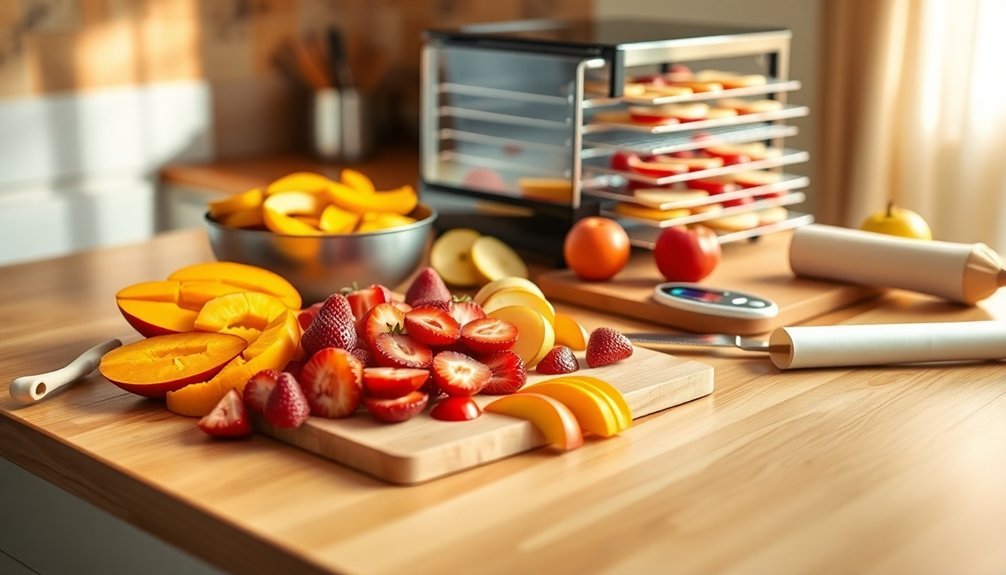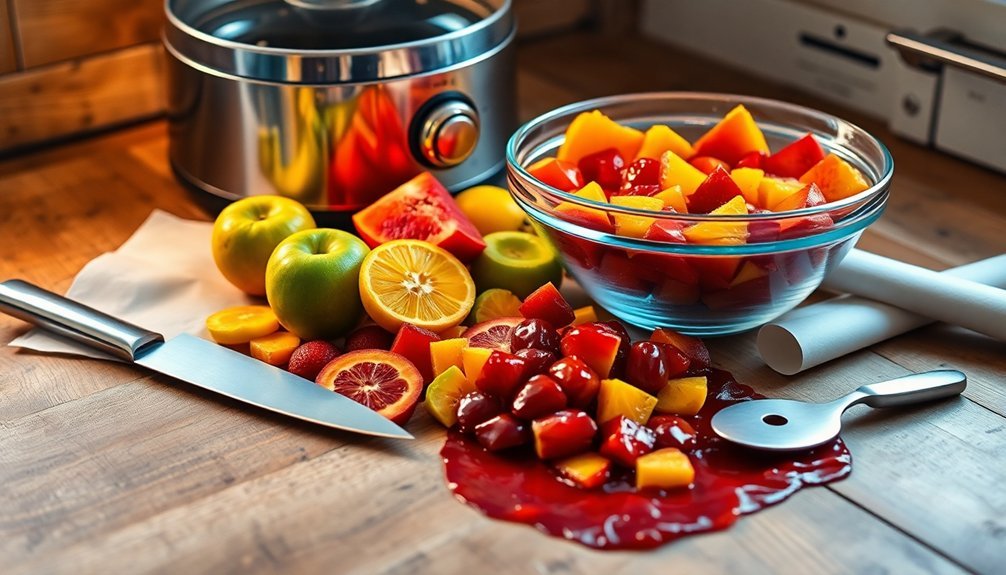To start making fruit leather, you need a few essential tools. A cutting board and sharp knives will help you prepare your fruits. You'll also need a blender or food processor for pureeing. An effective dehydrator is vital for drying the fruit leather, or you can use your oven with careful monitoring. Don't forget silicone baking mats or parchment paper for easy removal. Measuring cups and a citrus juicer can enhance flavor and keep your color fresh. With these tools, you're ready to create delicious fruit leather. Stick around, and you'll pick up more tips and techniques to make your process smoother.
Essential Preparation Tools

When you're ready to make fruit leather, having the right preparation tools on hand makes all the difference. Start with a sturdy cutting board and a few knives—both a paring knife for peeling and a chef's knife for chopping will help you prepare your fruits efficiently.
Don't forget a vegetable peeler for those fruits that need it. After cutting, a colander is essential for rinsing your fruits thoroughly. You'll want to store your prepared fruits in a medium bowl, while a small bowl can be handy for holding any juice or seeds you might extract.
Using a citrus juicer is a smart move, too, especially when adding lemon juice to prevent browning. For cleaning and rinsing, running water is a must, along with a fine mesh strainer for removing seeds and excess liquid.
If you're working with high-water content fruits, cheesecloth can help strain out that extra moisture. Finally, having an offset spatula or large spoon will make it easier to spread the puree evenly on your drying trays or baking sheets. It's also beneficial to consider that mixing different fruits can enhance the flavor combinations of your fruit leather.
With these tools in your arsenal, you're well-prepared to jump into making delicious fruit leather!
Blending and Mixing Equipment
When you're ready to create your fruit leather, having the right blending tools is key. You'll want to choose a blender or food processor to puree your fruit smoothly, and measuring accurately guarantees the perfect balance of flavors. Properly dried leather should be flexible, which is crucial for achieving the desired texture in your fruit leather. Let's explore the essential blending equipment, effective mixing techniques, and how to measure your ingredients precisely.
Essential Blending Tools
Blending fruits into a smooth puree is crucial for making delicious fruit leather, and having the right tools makes all the difference. Here are some essential blending tools you'll need:
| Tool | Purpose | Notes |
|---|---|---|
| Blender | Puree fruits until smooth | A high-powered model is best |
| Citrus juicer | Add lemon juice for flavor and preservation | Helps prevent darkening |
| Measuring cup/spoons | Guarantee accurate measurements | Key for consistent results |
You can use a cutting board and a chef's knife to prep your fruits, cutting them into manageable chunks. An immersion blender is a great option for smaller batches, while a high-powered blender will handle various types of fruit, guaranteeing a silky texture. Don't forget a colander for draining excess juice and a spoon or spatula to transfer your puree to dehydrator sheets. Adding lemon juice helps to prevent darkening and maintains the vibrant color of your fruit leather. Optional enhancements like applesauce, honey, and spices can also elevate your fruit leather's flavor. With these essential blending tools, you're well on your way to creating tasty fruit leather that you and your family will love!
Mixing Techniques Explained
To create delicious fruit leather, mastering mixing techniques is crucial. Start by selecting the right blending equipment. High-powered blenders like Vitamix are perfect for turning your fruit into a smooth puree. While regular blenders can work, gear juicers with a blank plate are ideal for achieving the best texture. Make certain your blender can handle at least six cups of fruit and blend until it's completely smooth, with no chunks remaining.
Next, it's time to mix your fruit puree with sweeteners like honey or agave syrup. Use your blender to combine these ingredients for a uniform consistency, or manually mix them with a spoon or spatula. Aim for a heavy pudding-like texture, which is best for fruit leather.
When preparing your fruit, choose ripe options, remove any blemishes, and cut them into small chunks. If you're using canned or frozen fruits, strain excess liquid and thaw them first.
Finally, spread your mixture evenly on dehydrator trays, keeping it about ⅛ to ¼ inch thick. This guarantees consistent drying and avoids air pockets that could ruin your fruit leather.
Measuring Ingredients Accurately
Accurate measurement of ingredients is fundamental for achieving the perfect texture and flavor in your fruit leather. Start with reliable measuring tools like measuring cups and spoons. These will help you get precise quantities of fruit and sweeteners. A medium bowl is great for mixing larger batches, while a small bowl works well for smaller portions.
When it comes to blending, a good blender or food processor is essential. A high-powered blender can give you a smoother consistency, which is critical for the final product. If you want an extra fine texture, a mill is an optional tool worth considering. Be certain to use the pulse function to control the blending process.
For preparation, a cutting board, paring knife, and chef's knife make chopping and peeling easier. A vegetable peeler is especially handy for tough-skinned fruits.
To guarantee uniform thickness in your fruit leather, consider using craft wood as spacers and securing them with masking tape.
Finally, don't forget your non-stick silicone baking mats or parchment paper and baking sheets if you're using an oven. These tools will help you create delicious fruit leather that's just right.
Spreading and Shaping Utensils

When it comes to spreading and shaping your fruit leather, using the right tools makes all the difference.
You'll want to grab an offset spatula or silicone spatula to guarantee an even layer, while wood spacers can help you achieve that perfect thickness.
With a few simple techniques, you can shape your puree for consistent, delicious results.
Essential Spreading Tools
Having the right spreading tools is essential for achieving a smooth and even layer of fruit puree when making fruit leather. You'll want to gather a few key utensils that will make the process easier and more efficient.
| Category | Essential Tools |
|---|---|
| Utensils for Spreading | Offset spatula, large spoon, third piece of wood |
| Tools for Thickness | Craft wood spacers, silicone mats, dehydrator sheets |
| Smoothing Devices | Blender, measuring cups, colander |
Start by using an offset spatula or a silicone spatula to spread your puree evenly. A large spoon can help you scoop and distribute the fruit mixture, while a third piece of wood can assist in pushing and pulling the puree into place. For maintaining a uniform thickness, craft wood spacers are invaluable, ensuring your fruit leather is consistent throughout.
Finally, using silicone mats or dehydrator sheets will give you a smooth surface for spreading and help prevent sticking. With these essential spreading tools in hand, you're well on your way to making delicious, homemade fruit leather!
Techniques for Shaping
Once you've gathered your spreading tools, it's time to focus on techniques for shaping your fruit leather. Start by using craft wood spacers to maintain a uniform thickness. Secure the spacers to your counter or cutting board with masking tape, then pour the fruit puree between them. This method guarantees even distribution and allows you to adjust the thickness based on your preference—try 1/8" or 1/4".
For an even shape, use a third piece of wood to push and pull the puree.
If your fruit consistency needs adjusting, consider thinning it by cooking the chopped fruit with water. Aim for a smoother texture, using ½ cup of water for every 4 cups of fruit. Strain excess liquid from high-water content fruits like watermelon for best results.
To guarantee even drying, make the edges of the puree thicker—about 1/4"—to prevent them from drying faster than the center. Keep the center around 1/8" thick.
Finally, tap the baking tray on the counter to eliminate air pockets and use a spatula to spread the puree smoothly across parchment paper. This will help achieve a perfect fruit leather.
Dehydration Devices and Methods
To effectively make fruit leather, you'll need the right dehydration devices and methods at your disposal. A dehydrator is your primary device for this task, with various models available—like the Excalibur, which offers multiple features to enhance your experience.
When using a dehydrator, line the trays with paraflexx sheets, parchment paper, or non-stick silicone mats to guarantee easy removal of your fruit leather.
If you don't have a dehydrator, you can use an oven, but keep a close eye on it to avoid uneven drying. Set the dehydrator temperature between 135-145°F (57-63°C) for best results.
Drying typically takes 6-10 hours, depending on the fruit type and moisture content. Spread your fruit puree to about ⅛ to ¼ inch thick for even drying.
Don't forget to check for dryness after 6 hours; the leather should come off easily and not leave indentations. For best results, rotate trays during the process, especially if your dehydrator has multiple levels.
Optional Tools for Consistency

Achieving consistency in fruit leather can greatly enhance your final product, making it more enjoyable to eat and easier to store. Using a few optional tools can help you achieve uniform thickness and even drying, guaranteeing a better result every time.
- Craft Wood as Spacers: Maintain uniform thickness for even sheets.
- Offset Spatula: Spread the fruit puree evenly to prevent uneven drying.
- Pastry Brush: Apply water to brittle edges, keeping your leather flexible.
- Dehydrator Racks: Rotate trays for even drying and easy monitoring.
- Kitchen Scale: Weigh fruit puree to keep portions consistent across batches.
These tools may not be strictly necessary, but they can meaningfully improve your fruit leather-making process.
Craft wood spacers help you set specific thicknesses, guaranteeing consistent drying. An offset spatula allows you to spread the puree evenly, which counters the common problem of uneven drying.
Using a pastry brush can maintain the flexibility of your leather, preventing cracks. Finally, rotating dehydrator racks ensure that all areas dry at the same rate, leading to a uniformly delicious final product.
With these optional tools, you'll elevate your fruit leather game!
General Supplies for Fruit Leather
Creating delicious fruit leather requires a variety of essential supplies that streamline the process and enhance your results. First, you'll need a dehydrator or oven for drying the fruit puree. A blender or food processor helps you achieve that smooth consistency. Make sure to have a cutting board, paring knife, and chef's knife handy for prepping your fruit.
For preparation, a citrus juicer, measuring cup, and measuring spoons are key to getting the right flavor and texture. A colander will assist in rinsing the fruit, while a vegetable peeler comes in handy for tough-skinned varieties. You'll also want an offset or silicone spatula for spreading the puree evenly.
When it comes to drying and shaping, stock up on fruit leather dehydrator sheets or parchment paper with a bit of spray oil. If you're using an oven, have baking sheets ready. Non-stick silicone baking mats are excellent for easy release.
Finally, cutting tools for coring, pitting, and destemming your fruit are vital, along with a fine mesh strainer for removing seeds and lemon juice for color preservation. With these supplies, you're set to make fantastic fruit leather!
Frequently Asked Questions
What Fruits Work Best for Making Fruit Leather?
When making fruit leather, you'll want to choose fruits like apples, strawberries, and blueberries. Combining high pectin fruits with drier options guarantees a smooth texture and enhances flavor in your homemade treat.
Can I Use Frozen Fruit for Fruit Leather?
Yes, you can use frozen fruit for fruit leather! Just thaw it, drain excess liquid, and puree it. Mixing with drier fruits improves texture. Follow drying instructions for delicious, homemade fruit leather. Enjoy your creation!
How Long Does Homemade Fruit Leather Last?
Homemade fruit leather lasts about 1-2 months at room temperature. If you store it in a cool, dry place or refrigerate, it can last up to 6 months. Freezing extends its shelf life to a year.
Is It Necessary to Add Sweetener to Fruit Leather?
You don't have to add sweetener to fruit leather if you use naturally sweet fruits. Their flavors intensify when dehydrated, so trust your taste preferences and let the fruit's sweetness shine through.
Can I Store Fruit Leather in the Refrigerator?
Yes, you can store fruit leather in the refrigerator. Make sure it's wrapped in airtight containers to maintain freshness and prevent moisture. It'll last up to a month, so enjoy it while it's good!
In Summary
Now that you know the essential tools for making fruit leather, you're ready to get started! Gather your preparation tools, blending equipment, and dehydration devices, and let your creativity shine through. Don't forget optional tools to guarantee the perfect texture and taste. With these supplies on hand, you'll be well-equipped to whip up delicious and healthy fruit leather at home. Enjoy experimenting with different flavors, and savor the satisfaction of your homemade treats!





Leave a Reply